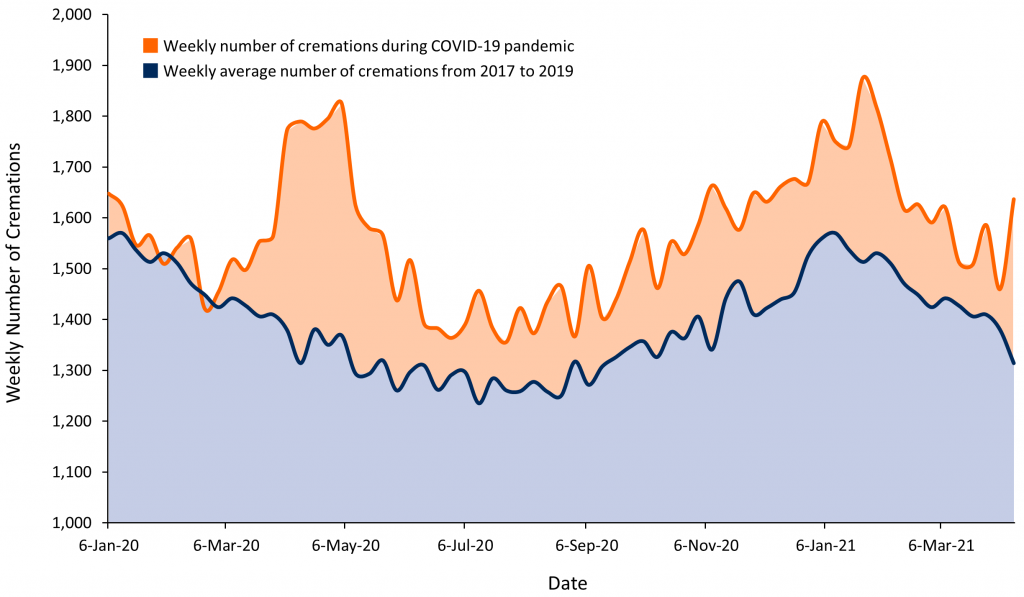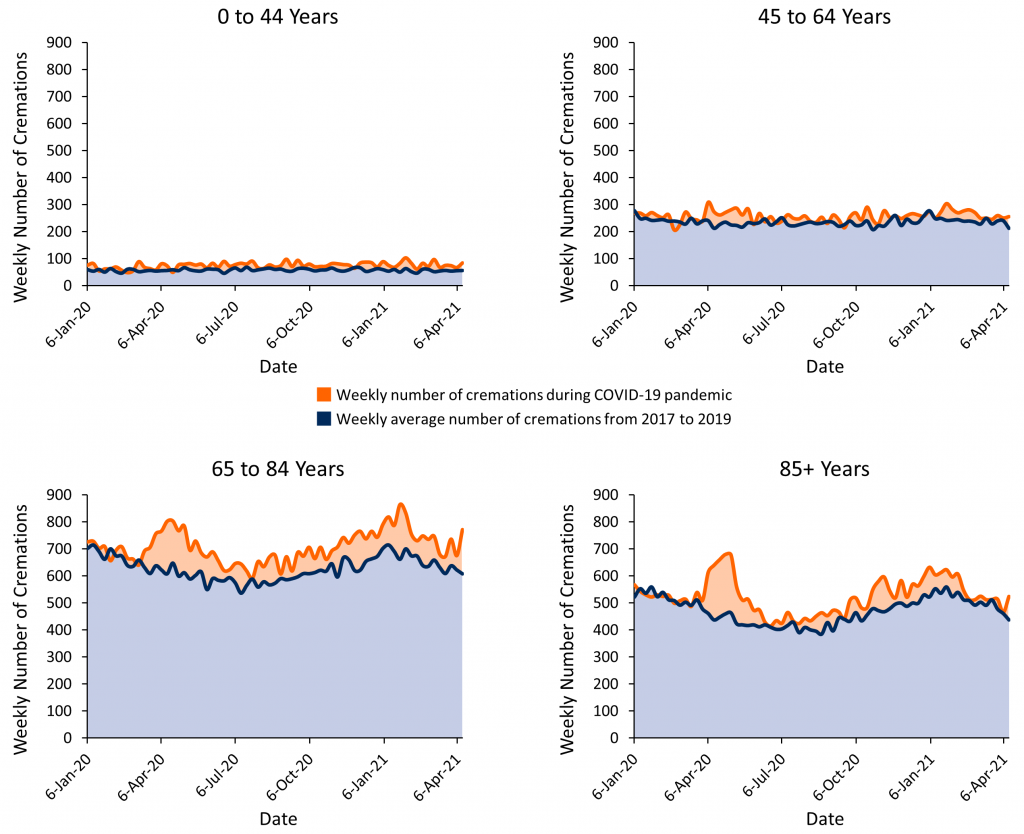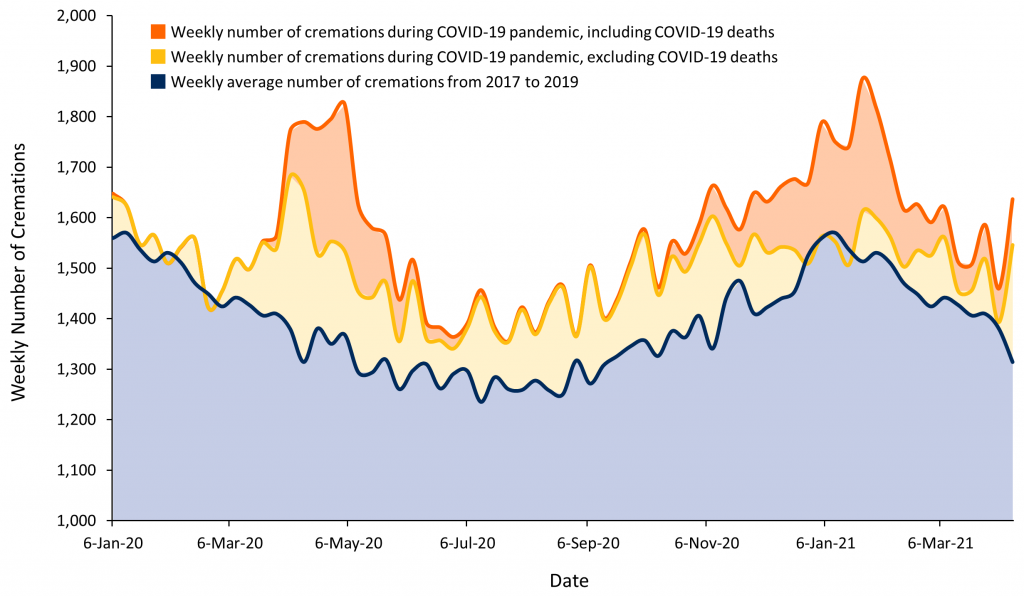Key Message
Based on Ontario cremation data, there has been a 12.8% increase in the number of deaths during the COVID-19pandemic, compared to the expected numbers of deaths informed by previous years’ cremation data. The causes of these excess deaths include infection with SARS-CoV-2, as well as causes likely related to the pandemic but not due to COVID-19 itself.
Summary
Background
Timely estimates of excess mortality are crucial for understanding the full impact of the COVID-19 pandemic on mortality. Increases in all-cause mortality have been reported by several countries during the COVID-19 period.1–6 Excess all-cause mortality will include deaths that are the result of infection with SARS-CoV-2 (recognized and unrecognized), as well as deaths that have been indirectly influenced by the pandemic, including those caused by delayed or deferred access to medical care and by worsening mental health and substance use . The impact of COVID-19 on all-cause mortality in Ontario is not well understood, and this is partially due to a delay of several months in the reporting of mortality data for Ontario by Statistics Canada because of routine data verification processes needed for official Vital Statistics records.7
Most cremations occur within three weeks of death; therefore, cremation data is a robust method of reporting mortality data that anticipates Statistics Canada mortality data by approximately five months.
In other countries, cremation data has been used to quantify mortality trends during the COVID-19 pandemic.8 In Ontario, a coroner is required to certify the cremation record before cremation can occur.9 Since 2017, this process has been digital, resulting in an electronic cremation record database. 70% of Ontarians are cremated, and 99% of those cremations occur within 3-weeks of their date of death. As such, cremation records provide a timely and robust source of provincial all-cause mortality data in the interim period before official Vital Statistics records are available.10 This analysis uses Ontario’s cremation data to estimate excess provincial mortality and to determine how much of the excess mortality is due to infection with SARS-CoV-2.
Questions
Has there been excess mortality in Ontario during the COVID-19 pandemic period, from March 2020 to April 2021, as compared to pre-COVID-19 years?
Is excess mortality observed in all age groups across Ontario?
How proportion of the excess mortality observed in Ontario during the COVID-19 pandemic is due to confirmed cases of COVID-19?
Findings
Excess Mortality During the COVID-19 Pandemic Period is Evident in Ontario Cremation Records
Ontario cremation records demonstrate that there was an increase in mortality in 2020, with an overall 12.8% increase in the number of cremations per week compared to baseline data (the average annual cremations seen in 2017, 2018, 2019 cremation data). The greatest increases in excess mortality were seen in April 2020 (+32.2%), May 2020 (+19.9%), and January 2021 (+17.0%). These months correspond to the peaks of the first and second waves of COVID-19 in Ontario (Figure 1).

The number of weekly cremations from January 1, 2019 to April 13, 2021 as compared with the average number of weekly cremations from years 2017 to 2019. All trends were smoothed using the Statsmodel Holt’s package; the default additive model was changed to an exponential model with a fixed smoothing slope (b = 0.2) and smoothing level (a = 0.6). Data sourced from Ontario’s electronic cremation certificates.
Cremation Records Show Excess Mortality in All Age Groups
In 2020, excess mortality was observed among all age groups (Table 1, Figure 2). The majority of these excess deaths (78.2%) were among those aged 65 years and older. The largest increase in the number of cremations in 2020 compared to the average number of cremations in 2017-2019 was observed among the youngest age group, with an additional 848 cremations, representing a 27.8% increase.

For the months spanning January to March 2021, excess mortality was again observed in all age groups (Table 1, Figure 2). The majority of the excess mortality (52.8%) was observed among those aged 65-84 years old. The largest relative increase in the number of cremations was again observed in the youngest age group, with a 44.2% increase in the number of cremations observed from January to March, 2021, compared to the same period in 2017-2019.

The number of weekly cremations from January 1, 2020 to April 13, 2021, as compared to the average number of weekly cremations from the years 2017 to 2019 in Ontario, by age group. All trends were smoothed using the Statsmodel Holt’s package; the default additive model was changed to an exponential model with a fixed smoothing slope (b = 0.2) and smoothing level (a = 0.6). Data sourced from Ontario’s electronic cremation certificates.
Confirmed Deaths Due to COVID-19 Cannot Explain All of the Excess Mortality
Deaths due to infection with SARS-CoV-2, as reported in cremation records, did not account for all of the observed excess mortality (Figure 3). During the first wave, from March to May 2020, confirmed COVID-19 deaths accounted for 43.5% of the 3,505 excess deaths in the cremation records. Some of the non-COVID-19 excess deaths in the first wave may be due to underreporting of confirmed COVID-19 cases, as testing was not readily available, and cases of COVID-19 may have been missed. However, during the early part of the second wave, from August to December 2020, when testing was more readily available, confirmed COVID-19 deaths accounted for 29% of the 3,812 excess deaths in the cremation records. Most recently, from January to March 2021, confirmed COVID-19 deaths accounted for 73.1% of the 2,337 excess deaths in the cremation records, with 26.9% of excess deaths attributable to other causes.

Weekly number of cremations from January 1, 2020 to April 13, 2021, including and excluding COVID-19 deaths, as compared with the average number of weekly cremations from 2017 to 2019. All trends were smoothed using an exponential model with a fixed smoothing slope (β = 0.2) and smoothing level (α = 0.6). Data sourced from Ontario’s electronic cremation certificates.
Interpretation
Ontario cremation records demonstrate that there has been excess mortality in Ontario during the COVID-19 pandemic and that the excess mortality is due to COVID-19 as well as non-COVID-19 causes. The large initial increase in mortality due to non-COVID-19 causes during the first wave of the pandemic, from March to May 2020, suggests that COVID-19 was underdiagnosed as a cause of death early in the pandemic in Ontario (Figure 3). The subsequent increase in mortality due to non-COVID-19 causes could reflect the impact of delays in care for conditions other than COVID-19, including cancer and cardiovascular care, in addition to other indirect effects of the pandemic, such as the increase in opioid-related deaths.11,12 Preliminary findings suggest that the largest absolute increase in opioid-related mortality has occurred among those aged 25 to 44 years.11
These findings in line with the excess mortality observed in other jurisdictions during the COVID-19 pandemic period.2–6Some potential causes of excess mortality that are not directly related to infection with SARS-CoV-2 include hesitancy to seek healthcare services, delays in access to healthcare, and mental health issues secondary to social isolation.5,6,13,14Several studies have shown a significant decline in the number of patients seeking emergency care for cardiac events during the pandemic, citing hesitancy or fear as the main cause.15–17 This trend is supported by data showing that Canadian emergency department volumes dropped by 50% during March and April, 2020.18 Some of the excess mortality may also be a result of delayed or deferred surgical procedures.19,20 Further, deaths due to acute drug toxicity, suicides, and violence secondary to the economic and social disruption of the pandemic have also been suggested as contributors to the increase in non-COVID-19 deaths.21
Methods Used for This Science Brief
Cremation records from 2020 and 2021 were compared to historical records from 2017 to 2019, grouped according to month and age. Excess mortality was defined and calculated as the number of cremations in 2020 and 2021 for a given month and age group that were greater than the expected number of cremations based on the observed average mortality for this month and age group between 2017 and 2019.
Deaths due to COVID-19 were isolated from the cremation records by the presence of the terms “COVID” or “novel coronavirus” in the cause of death, antecedent cause, or other cause of death categories. These were the only terms found to describe COVID-19 deaths in the cremation records. Records that matched the above criteria, but also contained the phrases “test-results pending,” “possible,” “not,” “non,” or “negative,” were excluded from the classification of death due to COVID-19.
Cremation data from 2020 was compared to 2020 mortality data from Statistics Canada (released April 2021) to determine whether the percent of Ontarians who were cremated changed during the COVID-19 pandemic. This comparison showed that, throughout the pandemic, there had been no change, in the percent of Ontarians who were cremated among all age groups.
All analyses were done using Python version 3.8.
References
1. Piccininni M, Rohmann JL, Foresti L, Lurani C, Kurth T. Use of all cause mortality to quantify the consequences of covid-19 in Nembro, Lombardy: descriptive study. BMJ. 2020;369. https://doi.org/10.1136/bmj.m1835
2. Michelozzi P, de’Donato F, Scortichini M, et al. Mortality impacts of the coronavirus disease (COVID-19) outbreak by sex and age: rapid mortality surveillance system, Italy, 1 February to 18 April 2020. Euro Surveill Bull Eur Sur Mal Transm Eur Commun Dis Bull. 2020;25(19). https://doi.org/10.2807/1560-7917.ES.2020.25.19.2000620
3. Olson DR, Huynh M, Fine A, et al. Preliminary estimate of excess mortality during the COVID-19 outbreak — New York City, March 11–May 2, 2020. MMWR Morb Mortal Wkly Rep. 2020;69. https://doi.org/10.15585/mmwr.mm6919e5
4. Docherty KF, Butt JH, Boer RA de, et al. Excess deaths during the Covid-19 pandemic: An international comparison. medRxiv. Published online May 13, 2020. https://doi.org/10.1101/2020.04.21.20073114
5. Bilinski A, Emanuel EJ. COVID-19 and excess all-cause mortality in the US and 18 comparison countries. JAMA. 2020;324(20):2100. https://doi.org/10.1001/jama.2020.20717
6. Institute for Health Metrics and Evaluation (IHME). Estimation of total mortality due to COVID-19. Institute for Health Metrics and Evaluation. Published May 6, 2021. http://www.healthdata.org/special-analysis/estimation-excess-mortality-due-covid-19-and-scalars-reported-covid-19-deaths
7. Statistics Canada. Weekly death counts, by age group and sex. Government of Canada. Published April 16, 2021. https://www150.statcan.gc.ca/t1/tbl1/en/tv.action?pid=1310076801
8. He M, Li L, Dehner LP, Dunn LF. Cremation based estimates suggest significant under- and delayed reporting of COVID-19 epidemic data in Wuhan and China. medRxiv. Published online June 16, 2020. https://doi.org/10.1101/2020.05.28.20116012
9. Government of Ontario. Office of the Chief Coroner: Cremation certificate process for families. Published 2020. https://www.mcscs.jus.gov.on.ca/english/Deathinvestigations/OfficeChiefCoroner/OCCCremationCertificates.html
10. Postill G, Murray R, Wilton AS, et al. An analysis of mortality in Ontario using cremation data: rise in cremations during the COVID-19 pandemic. MedRxiv. Published online July 24, 2020. https://doi.org/10.1101/2020.07.22.20159913
11. Public Health Ontario. Interactive Opioid Tool. Public Health Ontario. Published March 2, 2021. Accessed May 14, 2021. https://www.publichealthontario.ca/en/Data and Analysis/Substance Use/Interactive Opioid Tool
12. The Ontario Drug Policy Research Network, The Office of the Chief Coroner for Ontario/Ontario Forensic Pathology Service, Public Health Ontario, Centre on Drug Policy Evaluation. Preliminary Patterns in Circumstances Surrounding Opioid-Related Deaths in Ontario during the COVID-19 Pandemic. Published online November 2020:24.
13. Woolf SH, Chapman DA, Sabo RT, Weinberger DM, Hill L, Taylor DDH. Excess deaths from COVID-19 and other causes, March-July 2020. JAMA. 2020;324(15):1562. https://doi.org/10.1001/jama.2020.19545
14. Our World in Data. Excess mortality during COVID-19: background. Our World in Data. Published 2021. https://ourworldindata.org/excess-mortality-covid#excess-mortality-during-covid-19-background
15. Clifford CR, May ML, Chow A, et al. Delays in ST-elevation myocardial infarction care during the COVID-19 lockdown: An observational study. CJC Open. Published online December 15, 2020. https://doi.org/10.1016/j.cjco.2020.12.009
16. Garcia Santiago, Albaghdadi Mazen S., Meraj Perwaiz M., et al. Reduction in ST-segment elevation cardiac catheterization laboratory activations in the United States during COVID-19 pandemic. J Am Coll Cardiol. 2020;75(22):2871-2872. https://doi.org/10.1016/j.jacc.2020.04.011
17. Rattka M, Baumhardt M, Dreyhaupt J, et al. 31 days of COVID-19—cardiac events during restriction of public life—a comparative study. Clin Res Cardiol. 2020;109(12):1476-1482. https://doi.org/10.1007/s00392-020-01681-2
18. Canadian Institute for Health Information. How COVID-19 affected emergency departments. cihi.ca. Published November 19, 2020. https://www.cihi.ca/en/covid-19-resources/impact-of-covid-19-on-canadas-health-care-systems/how-covid-19-affected
19. Lai AG, Pasea L, Banerjee A, et al. Estimated impact of the COVID-19 pandemic on cancer services and excess 1-year mortality in people with cancer and multimorbidity: near real-time data on cancer care, cancer deaths and a population-based cohort study. BMJ Open. 2020;10(11):e043828. https://doi.org/10.1136/bmjopen-2020-043828
20. Eskander A, Li Q, Hallet J, et al. Access to cancer surgery in a Universal Health Care system during the COVID-19 pandemic. JAMA Netw Open. 2021;4(3). https://doi.org/10.1001/jamanetworkopen.2021.1104
21. Garber AM. Learning from excess pandemic deaths. JAMA. 2021;325(17):1729. https://doi.org/10.1001/jama.2021.5120
Document Information & Citation
Author Contributions: RM and LR conceived the Science Brief. GP conducted all analyses and wrote the first draft of the Science Brief. All authors revised the Science Brief critically for important intellectual content and approved the final version.
The authors thank Dr. Dirk Huyer, Chief Coroner for Ontario, for the vision and support to analyze cremation certificates as a timely source for mortality data.
Citation: Postill G, Murray R, Wilton AS, et al. Excess mortality in Ontario during the COVID-19 pandemic. Science Briefs of the Ontario COVID-19 Science Advisory Table. 2021;2(29). https://doi.org/10.47326/ocsat.2021.02.29.1.0
Author Affiliations: The affiliations of the members of the Ontario COVID-19 Science Advisory Table can be found at https://covid19-sciencetable.ca/.
Declarations of Interest: The declarations of interest of the members of the Ontario COVID-19 Science Advisory Table, its Working Groups, or its partners can be found at https://covid19-sciencetable.ca/. The declarations of interest of external authors can be found under Additional Resources.
Copyright: 2021 Ontario COVID-19 Science Advisory Table. This is an open access document distributed under the terms of the Creative Commons Attribution License, which permits unrestricted use, distribution, and reproduction in any medium, provided that the original work is properly cited.
The views and findings expressed in this Science Brief are those of the authors and do not necessarily reflect the views of all of the members of the Ontario COVID-19 Science Advisory Table, its Working Groups, or its partners.
